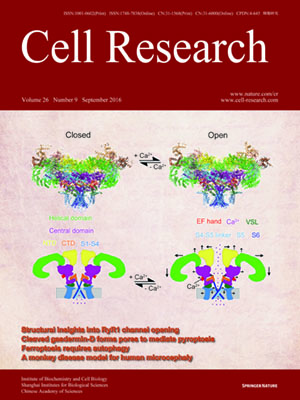
Volume 26, No 9, Sep 2016
ISSN: 1001-0602
EISSN: 1748-7838 2018
impact factor 17.848*
(Clarivate Analytics, 2019)
Volume 26 Issue 9, September 2016: 995-1006 | Open Access
ORIGINAL ARTICLES
The Central domain of RyR1 is the transducer for long-range allosteric gating of channel opening
Xiao-Chen Bai1,*, Zhen Yan2,3,4,*, Jianping Wu2,3,4,*, Zhangqiang Li2,3,4 and Nieng Yan2,3,4
1MRC Laboratory of Molecular Biology, Cambridge Biomedical Campus, Cambridge CB2 0QH, UK
2State Key Laboratory of Membrane Biology, Tsinghua University, Beijing 100084, China
3Beijing Advanced Innovation Center for Structural Biology, Tsinghua University, Beijing 100084, China
4Tsinghua-Peking Joint Center for Life Sciences, School of Life Sciences and School of Medicine, Tsinghua University, Beijing 100084, China
Correspondence: Nieng Yan, E-mail: nyan@tsinghua.edu.cn; Zhen Yan,(yanz11@mails.tsinghua.edu.cn)
The ryanodine receptors (RyRs) are intracellular calcium channels responsible for rapid release of Ca2+ from the sarcoplasmic/endoplasmic reticulum (SR/ER) to the cytoplasm, which is essential for the excitation-contraction (E-C) coupling of cardiac and skeletal muscles. The near-atomic resolution structure of closed RyR1 revealed the molecular details of this colossal channel, while the long-range allosteric gating mechanism awaits elucidation. Here, we report the cryo-EM structures of rabbit RyR1 in three closed conformations at about 4 Å resolution and an open state at 5.7 Å. Comparison of the closed RyR1 structures shows a breathing motion of the cytoplasmic platform, while the channel domain and its contiguous Central domain remain nearly unchanged. Comparison of the open and closed structures shows a dilation of the S6 tetrahelical bundle at the cytoplasmic gate that leads to channel opening. During the pore opening, the cytoplasmic “O-ring” motif of the channel domain and the U-motif of the Central domain exhibit coupled motion, while the Central domain undergoes domain-wise displacement. These structural analyses provide important insight into the E-C coupling in skeletal muscles and identify the Central domain as the transducer that couples the conformational changes of the cytoplasmic platform to the gating of the central pore.
10.1038/cr.2016.89
FULL TEXT | PDF
Browse 1874


